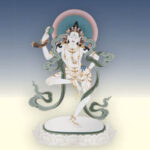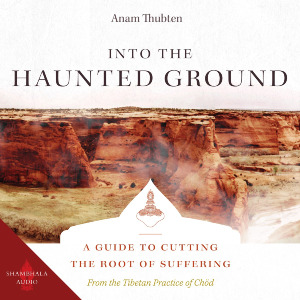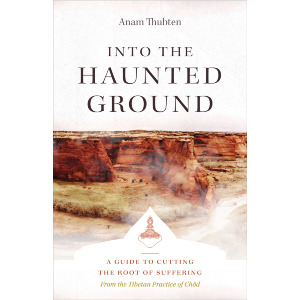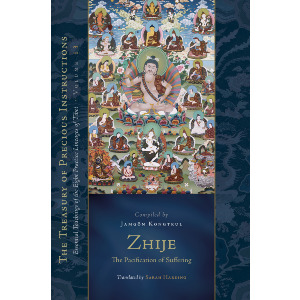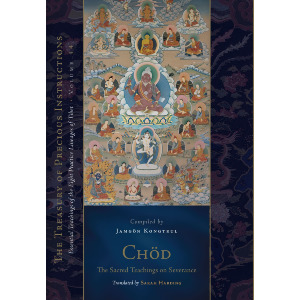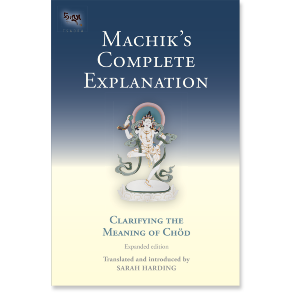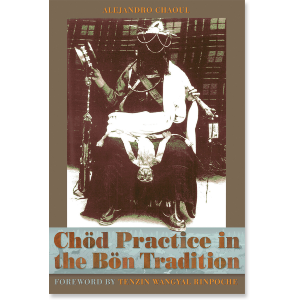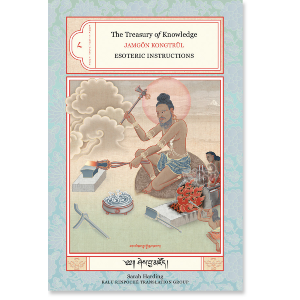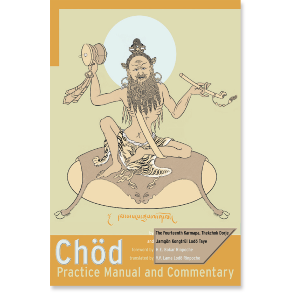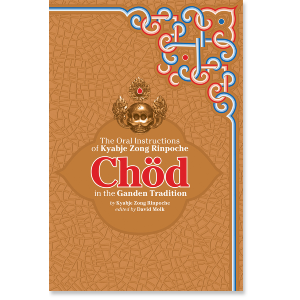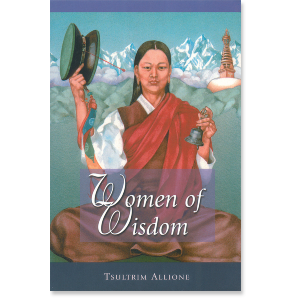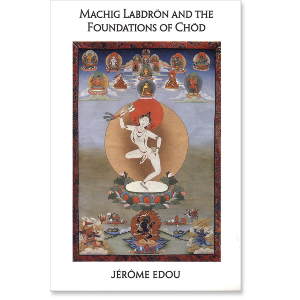| The following article is from the Summer, 1991 issue of the Snow Lion Newsletter and is for historical reference only. You can see this in context of the original newsletter here. |
Machig Lapdron.
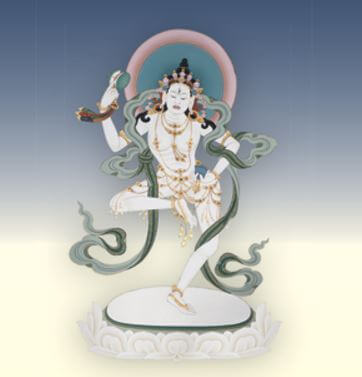
Machig Lapdron popularized and applied Mahayana Buddhism, particularly the Prajna Paramita Sutra, as well as aspects of ancient Bon practices. The drum used in the Chod practice is similar to the drum used by Siberian shamans. It has two sides and two pellets hanging down on either side which strike on opposite sides as the drum is turned, symbolizing the union of opposites. The purpose of the practice is to overcome attachment, with the added benefits of being able to heal the sick, stop epidemics, and become impervious to contagious disease. For example, the practitioners of Chod were called in to handle infectious epidemics, since they did not become infected by the disease.
The Chod practice directly addresses demons, obstacle makers and karmic debtors. When we hear about demons there's a tendency to think, this is a primitive belief which has nothing to do with me. However, as is often the case when Tibetan methods are truly understood, they reveal themselves to be a very sophisticated way of working with energy.
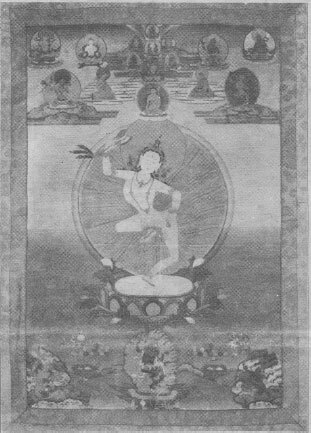
More and more scientific and medical research is proving the concrete effects of negative thought patterns on our health. We all have our personal demons who undermine our positive efforts and wreak havoc in our lives. We have demons that fear success or failure, we have demons telling us we aren't good enough, demons fearing death and sickness, we have the demons of our addictions and obsessions, we have the demons arising from our karmic patterns and early childhood which plague us day and night, not to mention the demons of disease. We have, for example, the demon of attachment who wreaks havoc in relationships. We have the demon of perfectionism who drives us to exhaustion and is still not happy. We have the demon of heroin, cocaine, alcohol, or tobacco who is always on our backs. We have the demon who always is starving, driving us to obesity. The varieties are infinite.
In the Chod the main demons mentioned are the demon of attachment to the body, the demon of death, and the demons of the poisons of passion, aggression and ignorance, the three main manifestations of dualism. Practically everything we do can be reduced to these three basic ploys of the ego. This is what happens: The ego is the central police headquarters which decodes experience into these three categories and then we take the action in response to whether central headquarters decides an object fixation is threatening, enhancing or uninteresting. Thus karma is created. It must be clearly understood that this does not mean that sense experience is demonic; rather, the attachment to the experience which blocks the state of awareness is the demon. When we freeze experience out of fear, this blocks the natural state. Freedom from dualism doesn't mean everything turns into a big mush of oneness. It means that we give up the manipulation of drawing certain experiences towards us and ignoring that which will neither enhance us nor threaten us. Chod is a powerful practice because it makes these responses conscious and leads to a state beyond dualism. Many of the great Dzog Chen practitioners practiced Chod, like Ayu Khadro, who traveled for years practicing Chod in lonely places and cemeteries.
Demons feed on negative thoughts, drain our life force, and come most frequently when we are unaware. A sloppy negative emotional state or simple distraction leaves us wide open for an external demon to attach itself. They begin by planting suggestions in our minds.
For example, the Demon of Abandonment starts suggesting that the person you love is going to leave you, and once that thought takes hold through attachment, the demon gains a foothold and begins to eat and grow stronger. Then the demon suggests that your husband or wife is, perhaps at this very moment, with someone else in bed having a great time!
The demon will start making these suggestions without you even noticing it, then suddenly you start feeling very insecure, and before you know it you can't think about anything else. Then the Abandonment Demon tells you things are going to follow their familiar pattern and you will be abandoned. This is a familiar experience, you've felt it all before. Your fear feeds and strengthens the demon. Sometimes the demon takes over to such an extent that murders are committed. Usually however, we simply become obsessed with jealousy and do crazy things because of it. Or less dramatically the possession of a demon begins very subdy and creates an undercurrent of discomfort or sickness.
From the point of view of Chod all samsaric existence is plagued by demons, and only when we are in state of ngpa are we free from them. The more obsessed we get the more the demon is slurping up the energy. We can have hundreds of demons possessing us at one time, but it all gets back to the basic fixation on dualism. So, here the basic problem is the attachment to the loved one. Where there is attachment, there is inevitably suffering. What we have idealized in the West as romantic love is attachment. This grasping can take many forms possessiveness, jealousy, paranoia, control. It does not lead to happiness, as we would like to believe.
In the Chod we take the demons outside of our body, give them a clear form and feed them whatever they want, and so our life force is no longer drained. We are making them conscious and dealing with them with awareness. When we are in a negative state psychologically everything gets muddled up. This is non-rigpa. Whenever we are in a state of marigpa then negative energies can attach themselves to us which match our energies. It is like fitting a key into a lock. There must be a receptive situation for a disease to embed itself. This can sometimes be the fear of the disease itself. So when our condition is weak or stressed or out of balance, we get sick easily, and we become like a magnet for the demons of sickness or negative spirits.
For this reason it is important to do practice when we are under stress and seek to balance our energy through meditation as soon as possible, because once the negativity gets a foothold it is harder to deal with. Sometimes a small flash or quick uprising of a negative emotion can cause big problems.
In the Chod, one gives one's demons a form and feeds them, so that they do not take over. In the case of the Abandonment Demon, I could see my Abandonment Demon as a little vampire girl with sharp teeth who is hungry for security and interferes in my relationships. The Tobacco Demon might be seen as thin yellow man with an evil face who is lonely and frightened under his seductive veneer. When I see the feeling of the grasping, I see a form. This helps to make things clear. For me this makes Chod something which is really applicable to my life, not just a fascinating foreign ritual.
On the absolute level the benefit of the Chod is the cutting of the very foundation of the self-clinging ego mind pattern which is undermined through the relaxation of dualism practiced in the Chod.
Since in the practice our body has been cut up and has become a substance which fulfills any desires, the demons can eat and eat until they are satisfied. They are fed through visualization. By taking our obsessions and attachments outside of ourselves and seeing their form, they become conscious. It is the unconsciousness that is so destructive. Once we can give something a name and form its power over us is much less, and if we can take it one step further, giving up the struggle and feeding these thought forms what they want, they truly lose their power. This is the relative value of the Chod practice.
The demon is our creation. Its entire existence depends on the amount of energy we feed it. It has no existence outside what we give it. Whenever we disconnect from our awareness, the demons begin to come around. When you are in an alert state, you dance on the demons, they're no longer a problem, the battle is over. Therefore the Yogini is fearless and dances on the heads of the demons. That's why at the beginning of the Chod you invite the Lamas, Yidams, Dakas, Dakinis and Protectors to witness you dancing on the bodies of dualism and attachment to samsara and nirvana. The demon needs a battle in order to have life; through resistance you give it your life force. When you consciously feed the demons in the Chod practice you are taking care of a part of yourself you hate by giving it love and compassion. You let go of the battle.
When we are afraid of a disease we draw it to us, we create a link, we visualize it coming to us. We feed the demon of disease through fear. Elizabeth Kubler-Ross, who works with the dying, says she can often tell what a person will die of, because it's their greatest fear. If I'm terrified of cancer I begin to visualize myself with cancer.
If the demon is fed through the Chod practice, it need not attach itself to our bodies. The monster is going to eat one way or another. If we feed it anger and frustration, it will continue to bother us. If we feed it love and compassion it will evolve. By loving the demon, it melts. The tension is the duality, and pushing the demons away makes more suffering, while pretending they don't exist makes a greater battle. An underground battle can be more insidious than a direct battle. If we can free ourselves of the demons we have fed, we can help others possessed by those demons. We can heal the diseases that we have ourselves experienced.
Before we feed the demons we also feed all the Buddhas, Bodhisattvas, Dakas, Dakinis, and Dharma Protectors, and afterwards we feed those with whom we have karmic debts, those who are making obstacles and all the beings of the six realms. So in a way, the entire phenomenal world has been fed, all attachment has been satisfied, and everyone has everything they want.
Freedom from conflict feels great and also unfamiliar. When I teach Chod and have people visualize feeding their demons whatever they want, invariably the demon disappears once the demon is fed. Then there is a moment of exhilaration followed by a frightened feeling. Who am I without my struggle? In the Chod practice after the offering is complete and everyone is satisfied, we recite a poem about the nature of things as they really are. So that the empty feeling is replaced by the View. The mind is described as being like a mirror, like a clear and cloudless sky, beyond definition and explanation, beyond karma and defilements.
So the temptation to fill in the space created by the absence of the demon is exchanged for an experience of pure, free awareness, the mind as a mirror. Toward the end of the practice it says that demons continue to arise, but self-clinging does not follow and in this way, through love and compassion, the demons evolve. Even though we feed the demons consciously, that doesn't mean they won't come back. Just because we refuse a cigarette once doesn't mean that demon is gone. Eventually, however, through love and compassion, the demons evolve and are liberated. The shadow is brought to light through acceptance. This is real love, accepting the shadow and letting it evolve into something else. The more we deny the shadow the more our lives are ruled by it.
The offering, the offered and offerer are all empty. We are told that from the Dzog Chen view there was never a problem, a problem maker or a solution to the problem. The whole thing is pierced, the bubble of illusion is popped. And at this point you are ready for it, because through the body offering you have let go of everything you are clinging to and can therefore begin to experience what is beyond attachment. The absolute value of the Chod is that it brings to experience what is beyond attachment. The absolute value of the Chod is that it brings us into the moment without correction, to our true condition which is underneath the ego's battle.
Eventually this process ends in the Body of Light. When the transparency of all that arises is seen as Dharmakaya, when it is experienced with this View on all levels, the body of light is a natural outcome. The Body of Light is the ultimate relaxation, it relaxation on a cellular level.
To me the Chod is a great practice for the Kali Yuga, when there are epidemics of all kinds around us. The forces of advertising, television, cinema and society's beliefs lead us toward our demons through fear and attachment. They teach us and our children: this is what you want, this is what you should be afraid of, and these things don't matter. They give us wrong views. Just like the loudspeakers in Tibet which broadcast propaganda day and evening, so too, our lives are surrounded by propaganda which gives us wrong views. The Chod gives us a very powerful way to work with our ourselves. It gives us a concrete tool to deal with our own negativity and a way to help others.
We experienced this very concretely last summer in Bali. At the beginning of the Dakini Retreat someone fell off a ladder backwards onto cement. She had a severe concussion and was unable to get up to go the toilet without nausea. Her back was also damaged. For several days she lay in extreme pain, crying if she had to move. Finally I thought she should go to the hospital, but before going we decided to do the Chod for her.
A group of us who knew the Chod gathered around her and we closed our eyes and did the practice. I saw great streams of demons leaving her and feeding from the skull cup. They were white and smoke-like with sticky fingers. At the end of the practice when we opened our eyes she was sitting up smiling and crying with gratefulness. She was a little stiff still, but she had no trouble walking, and she fully recovered in a few days. This is made possible through the blessings of the Guru Namkhai Norbu Rinpoche and the Lineage from Machig Lapdron, precious mother, who gave these teachings almost a thousand years ago. The profundity and wisdom of the methods is beautiful, and the results are concrete.

